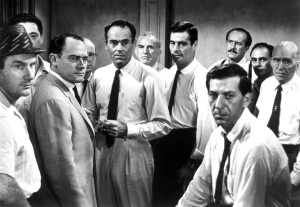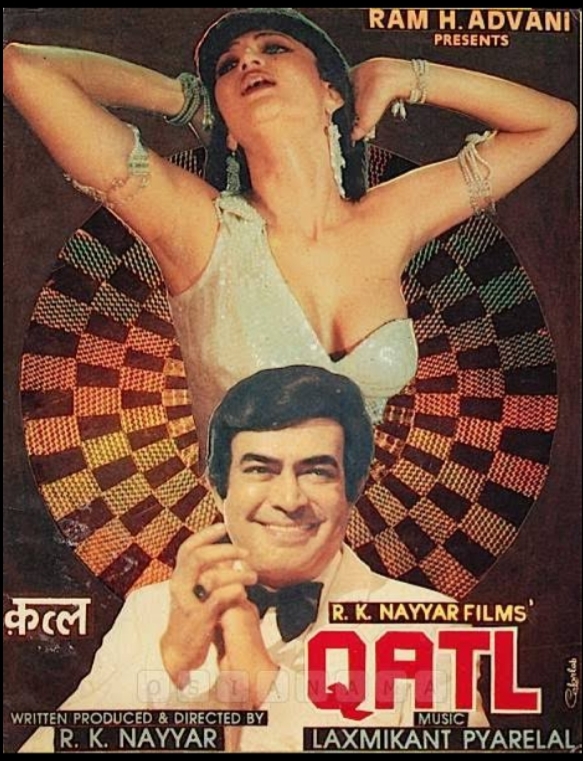aaLAWchak: 12 Angry Men
…Well, they say books are your best friend; they indeed are. However, sometimes it’s not a bad idea to leave them on your shelf and go beyond those black and white letters. This new year, we present you, ‘aaLAWchak‘. An Aalochak is a critic. In this section, we will talk about, criticize and review films and books related to courts, law and judicial process. That’s why we gave ‘Aalochak’ our own twist and termed it as aaLAWchak. Here, we cover law on celluloid and fiction.
In our first post, we bring you, Sidney Lumet’s 12 Angry Men, a movie on a murder trial and jury decisions of holding the accused guilty only when he is proved guilty beyond reasonable doubt.
Movie: 12 Angry Men
Starring: Henry Fonda and 11 other Angry Men
Directed by: Sidney Lumet
Year of Release: 1957
In its structure and surface, 12 angry men is a film on a “dozen men” contemplating an important decision while on a jury that could serve justice or end a life. But in its motive, it is a speech on the concept of fair trial and the rights of a citizen of a country when he is convicted of a crime. It takes place in rectangular, plain and claustrophobic room in New York.
The entire movie takes place in real time and within the room except one court room scene where the Judge in a harsh tone ask the jurors to “separate the fact from the fancy” when they are entrusted with the decision of whether a young adolescent boy is guilty of a murdering his father or not.
Through the course of the movie, you are introduced to the Jurors one by one. Each comes from a different background and carries his own way of thinking and they all together need to come to a single conclusion (Guilty or not Guilty). One of the theme in coming to this conclusion is prejudice, a number of times in the movie the Accused and his father are referred to as “these people”. It is shown that some Jurors believe the boy is guilty not because of the evidence but because he belongs to the lower strata of society. It is stated by some Jurors that killing your own father is common among “these type of people”. But faith in humanity is restored in one scene, when Juror No. 10 goes of in a rant of how such people are polluting the society and are devil’s own. He reiterates its best to kill them all and to start with the Accused. The Jurors who even believe the Accused to be guilty are not comfortable with this belief. They all slowly turn their backs to Juror No. 10 and his prejudice until he is told to shut up. Hence proving, that not all men are blind enough to let their prejudice over ride their conscience. It can easily be considered as the most powerful scene in the entire film.
Henry Fonda who was the only bankable star in the movie and plays Juror No. 8 remarks at one point “I don’t know. Nobody really can. But we have a reasonable doubt, and that’s something that’s very valuable in our system. No jury can declare a man guilty unless it’s sure.” Each one of the jurors is an intelligent man in his own right, they decide not to think because it seems like an open and shut case. However, Henry Fonda it seems is the only one who takes the Judges words seriously. He argues the evidence is circumstantial and he a young boy and his life cannot come to an end based on circumstantial evidence till all reasonable doubt has been removed from his mind.
The Jurors decide to hold a secret ballot minus Juror No. 8 who is considered as an adamant fool till then and see if anyone else also believes the Accused to be not guilty. However, when a chit with “Not Guilty” is presented Juror No. 9 states he wants to know what Juror No. 8 wants to say.
In hindsight you realize that it is this one chit that saves the Accused’s life.
The viewer is introduced to the evidence as if viewer is a part of the Jury. It is diligently analyzed and what seems obvious deduction at first, is questioned by the Juror No. 8 each time showing another perspective proving the Accused not to be guilty. The murder weapon is introduced(a switchblade knife), which is considered rare due to its design till Juror No. 8 produces a similar one proving that the weapon is common and if he could have it anyone could have bought it.
The credibility of the two witnesses that are only referred to as the “Old man” and “The women across the street” is also brought into doubt by the Juror No. 8.
Slowly, the vote which at the start was 1-11 for not guilty and guilty is gradually changed to all for not guilty, because of reasonable doubt, as each of the jurors more then coming to terms with the evidence of the Accused being not guilty are coming to terms with their own limiting beliefs.
However, not all Jurors can be considered prejudiced against the Accused for his ethnic roots. The Juror No. 4 is a character that stays in your mind, as he is a man who does not fall for emotions and applies his logic and comes to a logical conclusion in all situations.
He maintains the Accused is guilty and is the pillar that the entire Guilty stance for the Accused stands on, till Juror No. 8 discredits the witnesses which are the final blow crumbling the opposition of the not guilty vote. It is only when Juror No. 4 changes the vote that the viewers release a sigh of relief.
The last remaining Juror No. 3 who only wants the Accused to be guilty is because his own son had disrespected him by punching him and left him forever He is not against the Accused but he believes a son can murder his own father because of the disrespect his own son showed him and he is ready to punish the Accused for the sins of his offspring. A classic case of misplaced anger, it is the sound of the conscience of the Juror No. 8 that he comes to terms with his own issues. The anger that would have ended the life of a young adolescent boy ends into a harmless rant of Juror No. 3. In his final act of rage, he tears the photo of his son and him. Thereby, emptying his casket of anger and hatred and replacing the contents with compassion, and changes his vote to not guilty.
At the end of the movie it is just not the Accused who is acquitted, but it is the Jurors who are also acquitted of their hatred, misplaced anger and lack of empathy all because of Juror No. 8’s stubbornness.
The last scene shows the Juror No. 8 walking away, like a classic badass. He is approached by Juror No. 9 from behind and they exchange names, the only time in the entire movie where the names of the character are mentioned. They then walk away into the sunset like a superhero duo who knows that they made the world a better place in their own way.
Legal Aspects:
MISPLACED PREJUDICE
The movie brings to light the fact that no matter how high a chair we are placed in totality we are all humans at the end of the day. We have our limiting beliefs, our prejudices and our laziness. The people deciding the cases are prone to this weakness where casteism, classism or ideological beliefs lead a man on trial on the verge of being destroyed. So, to be ever in position where we judge we are to let go of beliefs and to embrace compassion and empathy a little more than logic or reason. Always keeping humanity prime and reasoning a very close second. The harshest decisions are to be reserved.
CIRCUMSTANTIAL EVIDENCE
The movie is a great example in reframing the evidence in situations with the aspect of forced perspective. It is a must watch for all criminal lawyers.
GUILTY BEYOND REASONABLE DOUBT
The concept of reasonable doubt is very well explained in the film. There is no other movie that has been able to explain the concept so well, supported by the credibility of the secondary evidence being bought into question. It also teaches fresh look to the concept of how a crime can be viewed to be advantageous to the Accused. While at the outset we are made to believe that the Accused is guilty and it seems obvious. The movie one by one and not at once discredits the prosecution grounds by application of pure and well placed logic. It will teach a new way of thinking to be incorporated for ones practice in law.
CONSENSUS BUILDING
The movie also teaches the problems in influencing someone. It shows the obstacles one faces when trying to change the opinion of others. The calm demeanor of Juror No. 8 and his logical persistence backed by on the feet thinking are all important for consensus building. It can be taken as text book example of how a person can achieve that and there is nothing better then a visual example for it.
Author: Govind K. Chaturvedi
Editor: Ankit Rastogi
Publishing Editor: Vivek K. Verma











